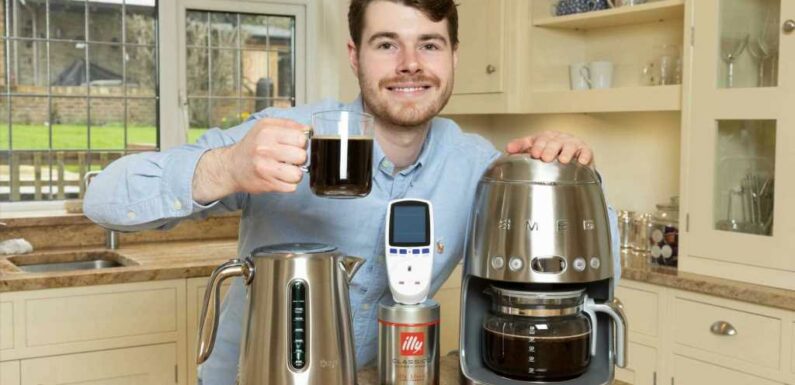
THERE are few things better than waking up to the smell of freshly brewed coffee – but what's the cheapest way to make it?
For those who don't drink instant coffee, a simple set-up consisting of a kettle and cafetiere does the trick.
But others may instead opt to use a filter or drip coffee machine like me.
These come with a higher upfront cost but are said to be cheaper to run because of their lower wattage.
My Smeg machine costs £199 brand new – I've had it for years and it's super reliable.
But shoppers looking for a new coffee maker don't need to break the bank.
Read more in money
I tried Nespresso pod dupes – one shop beat the big brand and is half price
Coffee sales continue to soar with two in three Brits visiting coffee shops to fuel the fastest growth on record
These gadgets can be bought brand new for as little as £14.98 at Currys.
So how much do they cost to run compared to using a kettle? I put it to the test.
I usually start my day with two strong cups of black coffee unless I'm in the mood for a Nespresso-based espresso.
So I invested in a £14.99 energy monitor plug from Amazon to calculate how much energy both my kettle and coffee machine used to brew two cups.
Most read in Money
Martin Lewis urges mobile users to 'send two texts' before bill hikes
Martin Lewis reveals little-known code that could save you £600 on bills
Costa reveals new Easter menu – and drinks are made with iconic chocolate bar
Primark is opening more Greggs cafes – see the full list of locations
According to both the gadget's manuals, the kettle's power is rated at 2,400 watts and the coffee machine is meant to draw 1,050 watts.
But as these are factory-tested ratings it's important to understand that the amount of power drawn by the device could vary considerably in the real world.
To work out how much it will cost to make a cup of coffee you need to do a bit of maths.
The equation is: cost = power (kilowatt) x cost of one kWh (pence) x the length of time (months or over a year).
Which was cheaper?
First up was the kettle. This took just two minutes and nine seconds to boil enough water for two cups, according to my smart plug.
The kettle drew 82 watts (0.082kWh) of power at that time.
Under the current energy price guarantee households on the standard variable tariff have their unit rates capped at 34.04p for every kilowatt hour of electricity used.
This means that it costs 2.79p to make two cups of coffee using a kettle and cafetiere.
If I was to drink two cups every day of the year, as I usually do, it would set me back £10.19 in total.
Next up was my trusty Smeg filter coffee machine.
This took three times longer than the kettle to heat and brewed two cups after six minutes and 18 seconds, according to my smart plug.
But the coffee machine only drew 55 watts (0.055kWh) of power at that time.
This means that with electricity unit rates capped at 34.04p, it cost 1.87p to make two cups of coffee.
If I was to use the machine to brew two cups every day of the year it would set me back £6.83 in total.
This means that, while it takes three times longer to brew, using a drip coffee machine is cheaper than using a kettle to quench your caffeine thirst.
By using my filter coffee machine instead of a kettle and cafetiere – I'm saving £3.36 a year on average.
The amount of savings will also increase if I choose to increase the amount of coffee I drink.
How can I cut the cost of making coffee at home?
One of the worst things you can do is fill up your kettle or machine with more water than needed in the first place.
If you're only after one quick caffeine fix but you fill the kettle up with enough water for eight cups, it's not only going to take a really long time to brew, but you'll be wasting energy heating the excess water.
Ben Gallizzi, energy expert at Uswitch said: "When making a cup of coffee, only fill your kettle or machine with as much water as you need for the number of drinks you are making.
"The more water used, the longer it will take to get to the right temperature and the more power it will be using."
Read More on The Sun
Inside terrifying £250k blackmail plot over Tesco Clubcards
I took my dog to groomer & now he looks like Richard Simmons
Turning off machines when they’re not being used is also a good way to crack down on unnecessary costs too.
Make sure you flip off the switch on the wall and unplug the appliance as leaving it on standby will continue to drain your bank account in the same way it drains the power from the wall.
Source: Read Full Article








